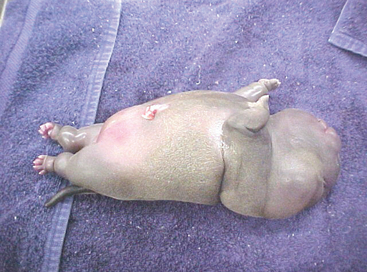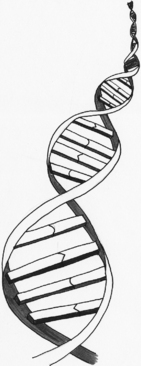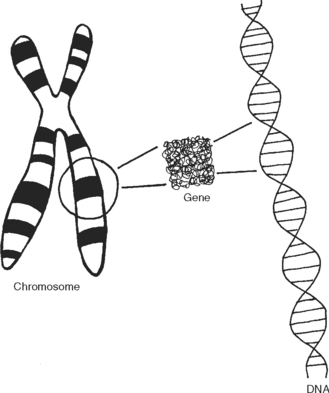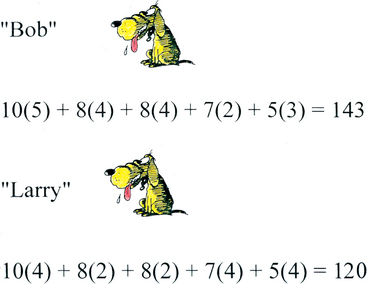29 Genetics
II. TRAITS AND UNITS OF HEREDITY
The negative aspect of a trait is called a defect. Thyroid hormone function is a trait; hypothyroidism is a defect. Some defects are hereditary, meaning they are due to genetic factors. These defects may or may not be obvious at birth. Some defects are congenital, meaning they are present when the animal is born. Abnormalities present at birth may be due to genetic, environmental, or developmental factors. For example, a puppy born with birth defects caused by drugs administered to the dam during pregnancy has a congenital defect that is not hereditary. Conversely, a dog with a genetic predisposition to mammary neoplasia that does not develop until she is 10 years of age has a hereditary defect that is not congenital. Some conditions are both congenital and hereditary (Figure 29-1). The terms congenital and hereditary must not be used interchangeably.
Deoxyribonucleic acid (DNA) is the most basic component of heredity. DNA is made up of two strands of bases, hooked together and twisted to form a double helix (Figure 29-2). Segments of DNA of differing lengths make up genes. The gene is the smallest unit of inheritance. Each gene encodes for a specific function within the animal, for example, production of a specific protein. Groups of genes make up chromosomes, like beads on a string (Figure 29-3). Each species has a certain number of chromosomes, with two copies in every cell of the body. Dogs have 78 chromosomes. One copy of each chromosome comes from the mother, and the other from the father. The only cells in the body that do not contain two copies of each chromosome are the gametes: the ova in the female and spermatozoa in the dog. Each of these cells contains one copy, so the new individual formed by fertilization of an ovum with one spermatozoon contains the appropriate number of chromosomes. This single cell, the fertilized egg or zygote, will divide and develop to form all the cells of the body, replicating these chromosomes (and genes) over and over.
Not all alleles are created equal. Within the various alternate forms, one usually is dominant to the others. The dominant allele will be expressed whenever it is present, even if the animal is heterozygous. Let us take as an example brown hair color. If the alleles involved are B = brown and b = blonde, and if B is the dominant allele, animals with either the BB or Bb gene combination will have brown hair. In this example, the b allele is recessive, meaning its presence is masked by presence of the dominant allele in heterozygous (Bb) animals. Only animals that are homozygous and recessive (bb) will have blonde hair color. Another example is eye color in humans. Ignoring hazel, green, and other eye colors, consider just brown (B) and blue (b). Brown is dominant, so individuals with the BB allele combination have brown eyes, as do those with the Bb allele combination. Only individuals with the bb allele combination have blue eyes (Figure 29-4).
III. MODES OF INHERITANCE
A. SIMPLE MENDELIAN WITH A SINGLE GENE
With simple mendelian inheritance, it is easy to predict the percentage of offspring with a particular genotype if the genotypes of the parents are known. Using eye color as an example again, if a woman is homozygous and brown-eyed, she has the BB combination of alleles. She has children with a man that is homozygous and blue-eyed; he must have the bb combination of alleles. All of her eggs contain the B allele. All of his spermatozoa contain the b allele. Since their children get one allele from their mother and one from their father, all the children will have the Bb allele combination and will be heterozygous and brown-eyed because the B allele is dominant. This can be expressed easily in a box diagram (Tables 29-1 and 29-2).
Table 29-1 Simple Mendelian Inheritance: Both Parents Homozygous
| MATERNAL GAMETES → | B | B |
| PATERNAL GAMETES | ||
| ↓ | ||
| b | Bb | Bb |
| b | Bb | Bb |
Of four offspring produced, all four will be heterozygous (Bb).
Table 29-2 Simple Mendelian Inheritance: Both Parents Heterozygous
| MATERNAL GAMETES → | B | b |
| PATERNAL GAMETES | ||
| ↓ | ||
| B | BB | Bb |
| b | Bb | Bb |
Of four offspring produced, one will be homozygous dominant (BB), two will be heterozygous (Bb), and one will be homozygous recessive (bb).
B. SIMPLE MENDELIAN WITH MULTIPLE GENES (POLYGENIC TRAITS)
The same rules apply as the preceding, but more than one gene controls expression of the trait. This is most common mode of inheritance for traits and defects of interest in veterinary medicine (Table 29-3). The number of genes controlling most traits is not known but is estimated to be in the tens or hundreds. That is why predicting appearance of a given trait in offspring, even from parents with well-known pedigrees, may be difficult.
Table 29-3 Simple Mendelian Inheritance for Polygenic Traits
| MATERNAL GAMETES → | b/e | b/e |
| PATERNAL GAMETES | ||
| ↓ | ||
| B/E | Bb/Ee | Bb/Ee |
| B/e | Bb/ee | Bb/ee |
| b/E | bb/Ee | bb/Ee |
| b/e | bb/ee | bb/ee |
Of eight offspring produced, two are black (Bb/Ee), two are chocolate (bb/Ee), and four are yellow (Bb/ee and bb/ee).
C. VARIATIONS FROM SIMPLE MENDELIAN INHERITANCE
2. Limited Expression
3. Sex-Linked Inheritance
In this type of inheritance, the gene affecting the presence of a trait is carried on the X or Y chromosome. Remember that females have two X chromosomes and males have one X and one Y chromosome. If a trait is carried on the X chromosome, expression is as for all other traits in females; for a recessive to be expressed, the individual must be homozygous. In males, because they only have one X chromosome, whatever allele they have will be expressed. An example from humans is color blindness. Color blindness is controlled by a single gene, and normal color vision is the dominant allele. The gene for color vision is on the X chromosome. If a man is color blind, because he only has one X chromosome he must have the abnormal allele and will pass that on to any daughters he has. He cannot pass it to his sons because they get his Y chromosome, which is what turns them into sons! A woman will have normal color vision if she is homozygous for normal color vision or heterozygous. If she is heterozygous, she is a carrier for color blindness because half of her eggs will contain the normal allele, and the other half will contain the abnormal allele (Table 29-4).
Table 29-4 Sex-Linked Inheritance







